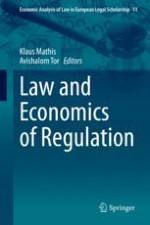2021 | OriginalPaper | Chapter
Sectoral Self-Regulation as Viable Tool
Author : Rolf H. Weber
Published in: Law and Economics of Regulation
Publisher: Springer International Publishing
Activate our intelligent search to find suitable subject content or patents.
Select sections of text to find matching patents with Artificial Intelligence. powered by
Select sections of text to find additional relevant content using AI-assisted search. powered by
